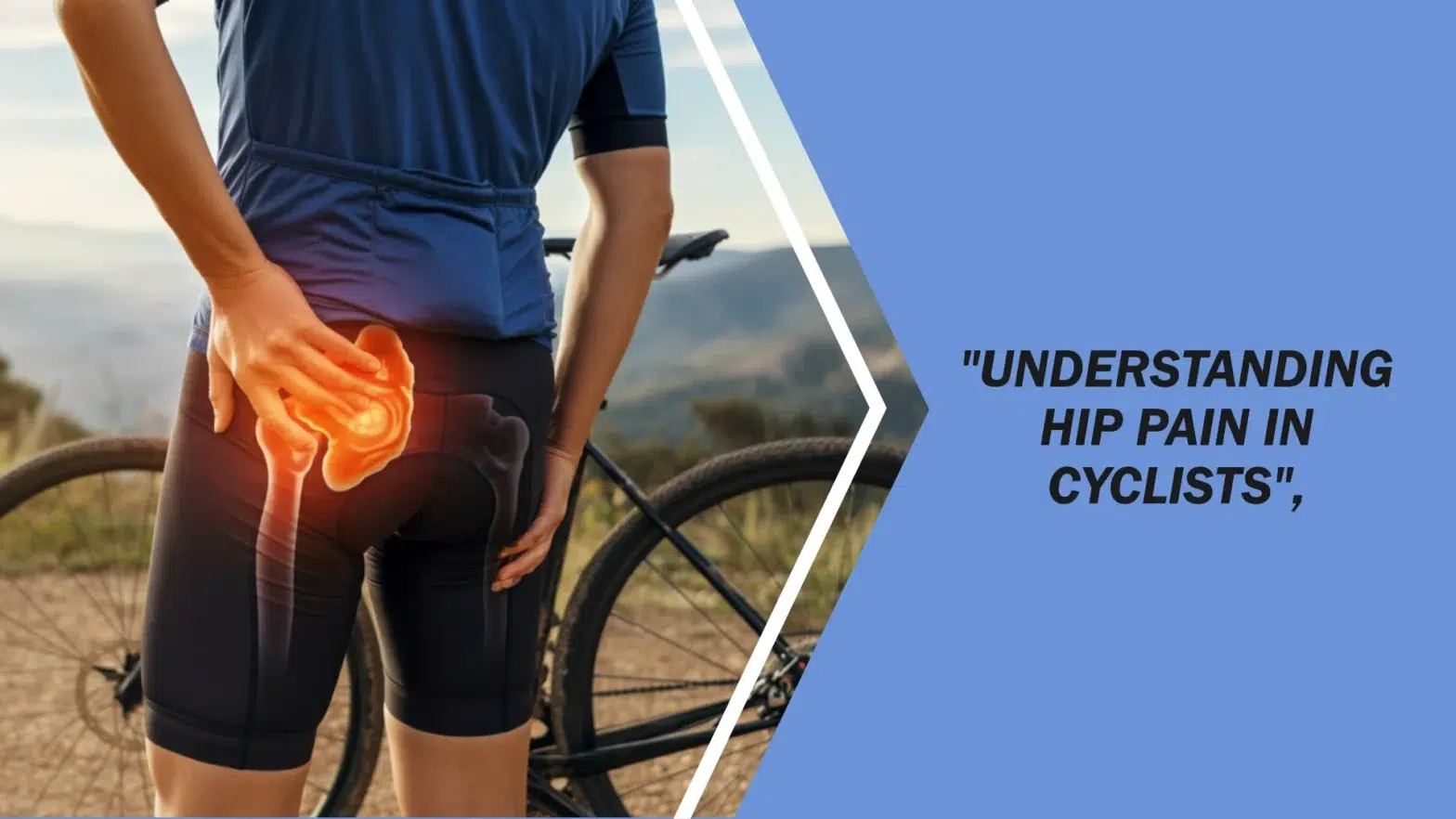Bursitis of the hip causes pain as its primary symptom. Hip swelling can also be a symptom of hip bursitis. Your hip bursitis pain usually gets worse after you sit or lie down. A repetitive activity may make pain worse.
The body’s position when riding a bicycle places most of the weight directly on the hips. This will likely result in more pain and worsening of bursitis. Biking should only be allowed once the patient has recovered from injury and should be started slowly and gently.
This post will cover the causes, symptoms, and treatments of hip bursitis in cyclists and the importance of hip health.
Cycling Hip Pain Bursitis: 8 Causes & 10 Treatments
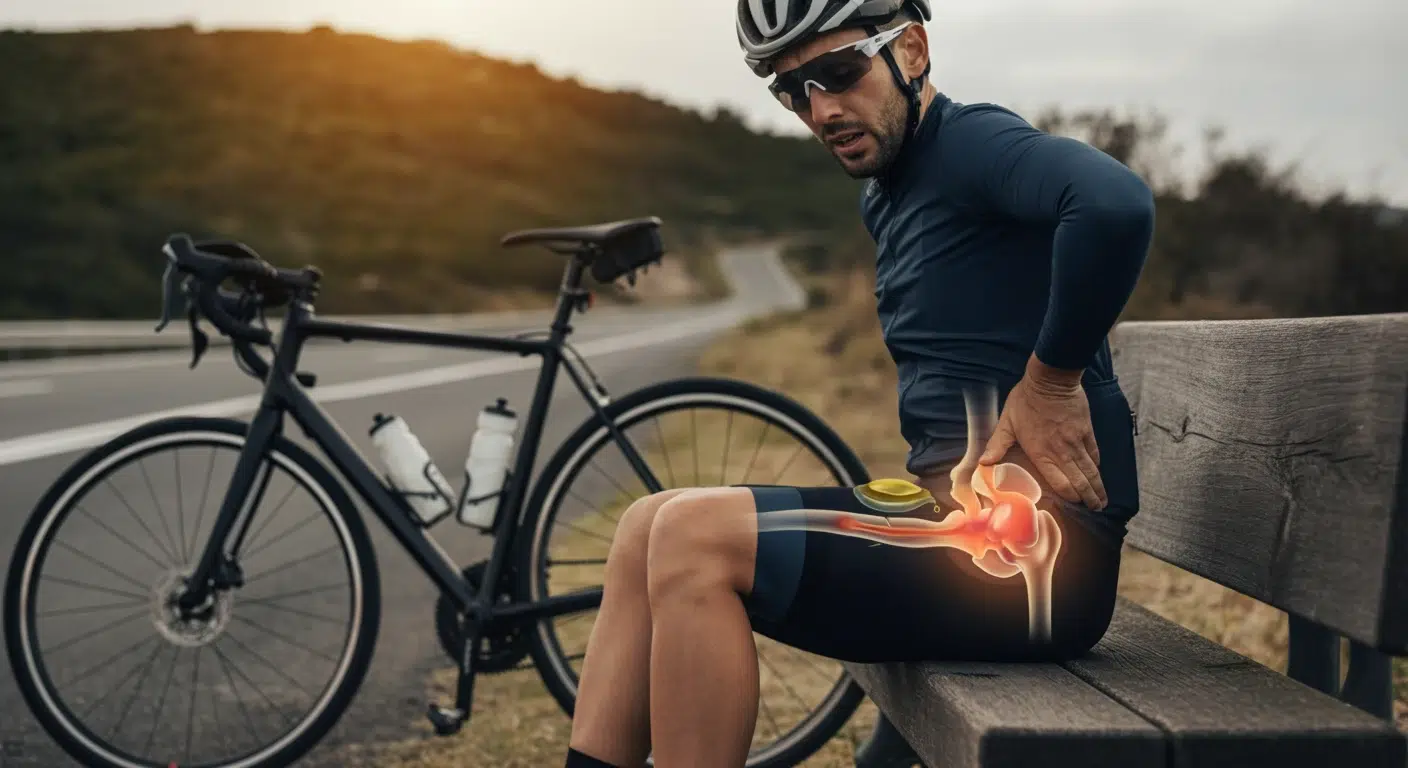
Why do my hips hurt after cycling? Hip bursitis is common among cyclists and is characterized by inflammation in the tiny fluid-filled sacs, or bursae, near the hip joint.
While the condition can be debilitating and negatively impact a cyclist’s performance, it is essential to understand the contributing factors to cycling hip bursitis to prevent and manage the injury effectively.
Overuse as a Primary Cause of Cycling Hip Bursitis
It is well-known that cycling for prolonged periods is a significant contributing factor to hip bursitis in cyclists. The repeated motion of the hip joint, combined with the constant pressure and friction caused by prolonged cycling, can cause inflammation of the bursae.
To prevent overuse injury, it is essential to:
- Increase the duration and intensity of cycling sessions.
- Plan regular rest days into your training schedule to allow for adequate recovery.
- Use proper bike fitting and positioning to avoid excessive stress on the hip joint.
Trauma and Infection as Secondary Causes of Hip Bursitis in Cyclists
Hip joint injuries or bacterial infections could also aggravate hip bursitis in cyclists. Trauma, such as a fall or collision, can directly impact the hip joint after cycling, resulting in bursitis. Bursitis can also occur if bacteria enter the bursae, causing an infection.
To prevent trauma and infection-related hip bursitis, it is essential to:
- Wear protective gear when cycling, such as a helmet and padded clothing.
- Avoid cycling in unsanitary conditions or environments that increase the risk of bacterial infection.
- Seek prompt medical attention if you show feverish symptoms, chills, or redness and swelling around the hip joint.
Arthritis and Other Risk Factors Associated with Cycling Hip Bursitis
Certain preexisting medical conditions and risk factors could increase the likelihood of developing hip bursitis in cyclists. Arthritis, which causes joint inflammation, could impact the hip joint and increase the risk of bursitis. Other risk factors include:
- Age: Advanced age may increase the risk of hip bursitis.
- Repetitive motion jobs: Occupations that require repetitive motion could lead to hip bursitis.
- Previous hip injuries: Earlier injuries to the hip joint could exacerbate the risk of developing hip bursitis.
To prevent hip bursitis in cyclists with preexisting medical conditions or risk factors, it is essential to:
- Consult with a healthcare professional before starting cycling or any physical activity.
- Work with a physical therapist to strengthen the hip joint and improve joint mobility.
- Engage in low-impact activities or cross-training to reduce the risk of overuse injury to the hip joint.
Hip Bursitis Causing Knee Pain
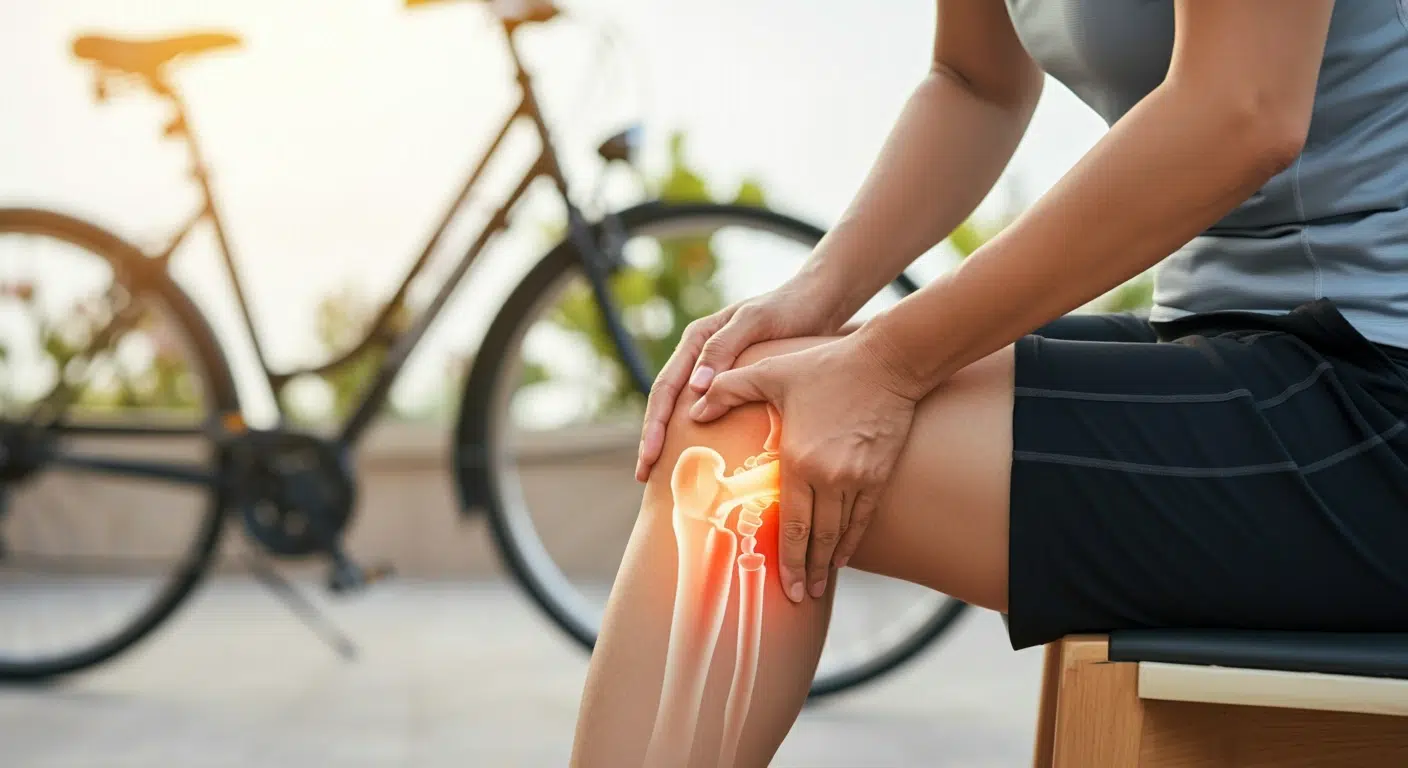
Hip bursitis, characterized by inflammation of the bursae near the hip joint, can sometimes lead to referred pain in the knee. The proximity of these joints and the interconnected nature of the musculoskeletal system can cause knee discomfort as a secondary symptom of hip bursitis.
Herniated Disc Leading to Hip Bursitis
While a herniated disc primarily affects the spine, its impact on nerve function and posture can indirectly contribute to conditions like hip bursitis and hip flexor cycling pain.
The altered mechanics and stress on surrounding tissues from a herniated disc can trigger or exacerbate hip bursitis symptoms.
Hip Bursitis Associated with Sciatica Pain
Sciatica, a painful condition along the sciatic nerve, can sometimes be caused by hip bursitis. Inflammation in the hip area may irritate nearby nerves, including the sciatic nerve, leading to sciatica symptoms such as leg pain, numbness, or tingling.
Cycling and Hip Pain
Cycling, while known for its cardiovascular benefits, can also contribute to hip pain and Outer Hip Pain if not performed with proper technique or equipment. Factors like poor bike fit, overuse of hip muscles, or incorrect riding posture can strain the hips during cycling, resulting in discomfort or the potential development of conditions like hip bursitis.
The Timing of Hip Pain In Cycling
Hip pain during or after cycling can significantly affect your riding experience and overall performance. Let’s explore the timing of hip pain in cycling, shedding light on why hips may hurt during or after bike rides:
Hip Pain While Cycling
Hip discomfort during cycling may result from improper bike fit, muscle fatigue, or poor riding posture. Adjusting your bike setup, taking breaks to stretch, and correcting your posture can ease hip pain.
Repetitive movements, muscle strain, or inadequate conditioning can also cause hip pain. To manage such discomfort, focus on proper form, add hip-strengthening exercises, and gradually increase ride durations.
Hips Hurt After Cycling
Hip pain after cycling can indicate muscle fatigue, overuse, or insufficient post-ride recovery. Hip soreness can be reduced by performing cool-down stretches, using foam rollers for muscle relief, and allowing adequate rest and recovery time.
Hip Bursitis in Cycling: Symptoms & Diagnosis
By knowing the symptoms, cyclists can identify when they need professional attention and seek proper diagnosis and advice. Here are the signs and symptoms of hip bursitis, how it can be differentiated from other hip ailments, and where to seek professional assistance.
Identifying Symptoms
Hip bursitis occurs when the tiny sacs of fluid between the hip bone and soft tissue become inflamed. Here are some of the symptoms of hip bursitis in cyclists:
- Pain on the outside of the hip, especially when lying on the affected side.
- Stiffness and restricted movement in the hip joint.
- Swelling and redness in the hip area.
- Aching or sharp pain after long periods of cycling.
- Pain when walking, climbing stairs, or engaging in other physical activities.
If left untreated, hip bursitis can lead to chronic pain and even affect a cyclist’s ability to ride. Paying attention to these symptoms and seeking proper diagnosis and advice is essential.
Common Signs and Symptoms of Cycling Hip Bursitis
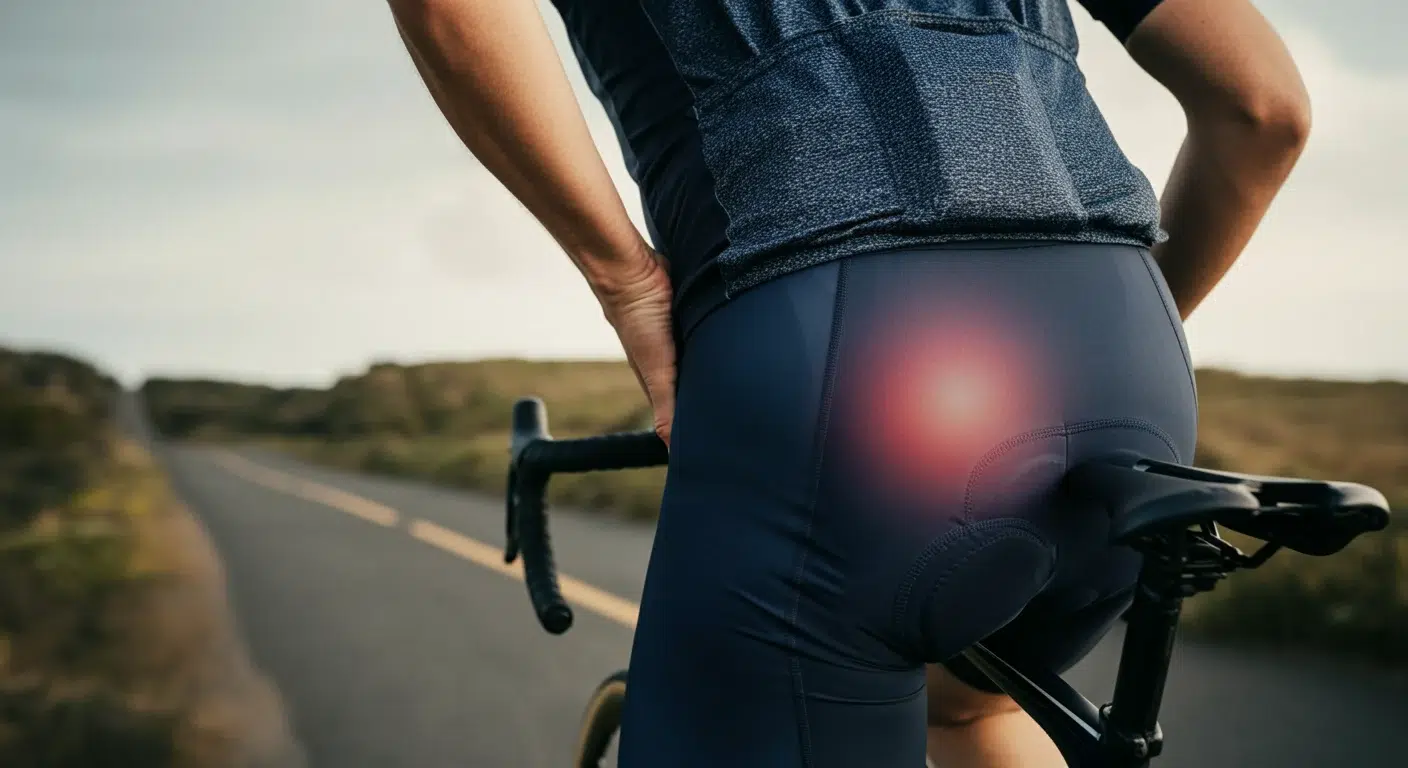
Some specific hip bursitis symptoms that are commonly found in cyclists include:
- Pain in the hip area is typically localized to the outer part of the upper thigh.
- A pain that worsens with pressure on the hip or when the hip is flexed.
- Pain occurs only during or after biking, mainly when the person is riding at a high intensity or for long periods.
Even if a cyclist is experiencing only one or two of these symptoms, it’s recommended that they seek attention from a medical professional.
Differential Diagnosis of Hip Bursitis Amidst Other Hip Ailments
Hip bursitis can be easily confused with other hip conditions, such as osteoarthritis or tendinitis. Therefore, a proper differential diagnosis is critical to provide the correct treatment. Here are some differences between hip bursitis and other similar conditions:
- While osteoarthritis causes joint damage, hip bursitis is caused by inflammation of the hip bursae.
- Tendinitis typically causes pain that radiates up and down the leg, while hip bursitis tends to be more localized.
- Unlike hip bursitis, sciatica pain radiates down the back of the leg and is caused by a compressed nerve.
Locating Professional Assistance for Diagnosis
When diagnosing and treating hip bursitis, seeking a medical professional is essential. One can start by visiting their primary care physician, who may refer them to an orthopedic specialist or a physical therapist. Other professionals to consider include:
- Sports medicine doctors.
- Chiropractors.
- Physiotherapists.
Seeking professional advice and treatment can help alleviate current symptoms, prevent future injuries, and ensure smooth cycling experiences.
Hip Bursitis in Cyclists: Effective Treatment Tips
Hip bursitis is characterized by inflammation of the bursae. Tiny fluid-filled sacs cushion the joints. Cyclists often develop hip bursitis due to repetitive pressure or friction from prolonged cycling. However, there are various ways to treat and prevent hip bursitis in cyclists:
Traditional and Alternative Ways
- Rest: The best way to recover from hip bursitis is to rest. Avoid cycling or other strenuous activities that cause pain, worsening your condition.
- Cold and Heat Therapy: Applying cold or heat therapy to your hip can help relieve pain and inflammation. Ice or frozen gel packs should be applied for 15-20 minutes at a time, several times a day, while heating pads should be used for 15-20 minutes once or twice daily.
- Medication: Taking ibuprofen or naproxen regularly can help reduce pain and inflammation in cases of hip bursitis. It is essential to use such medicines only under the guidance of a physician.
- Physical Therapy: Physical therapy can strengthen your hip muscles and improve your range of motion. Physical therapists can help you identify hip stretches and exercises to relieve pain and prevent future injuries after cycling.
Improvement of Cycling Habits and Monitoring Bike Fit:
- Adjusting Bike Fit: Properly adjusting your bike can help alleviate hip bursitis. This includes changing your seat height, handlebar height and reach, and pedal stance width. A high seat is more likely to cause hip pain than a low one.
- Changing Riding Position: Standing up or moving your hands to different positions on the handlebars can alleviate pressure on your sore hips while/after cycling.
- Taking Breaks: Taking breaks during long rides can help reduce the time your hips are under pressure and the risk of hip bursitis.
Cycling Hip Bursitis Exercises and Stretches
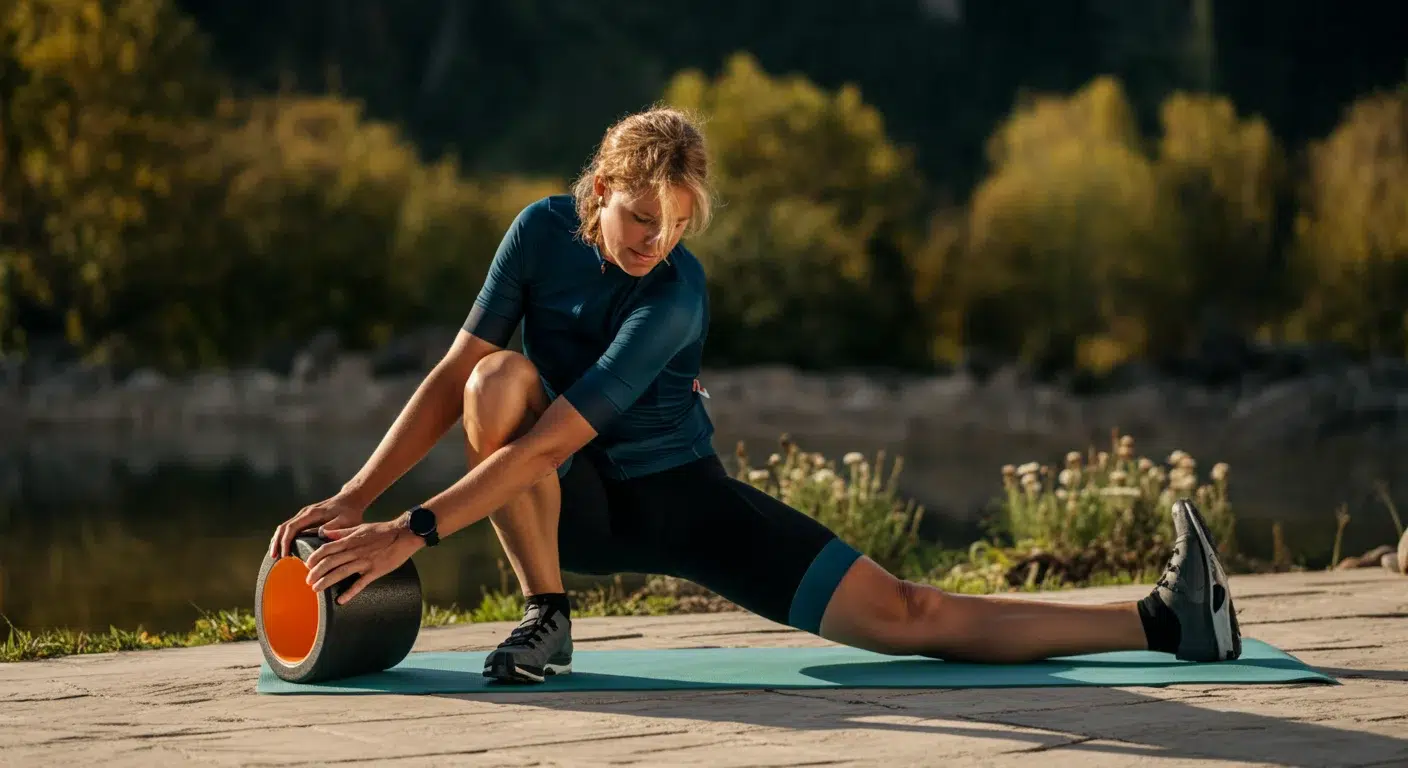
For those experiencing hip pain, mainly due to bursitis, finding suitable exercises can be pivotal in managing discomfort and promoting healing. Exploring exercises tailored to address hip bursitis, especially on an exercise bike, can offer relief and aid recovery.
- Hip Flexor Stretch: Place your opposite foot flat on the ground, lean forward to stretch your hip flexor muscles, hold for 30 seconds, and switch sides. Hip flexor stretches are beneficial for front hip pain after cycling.
- Glute Strengthening Exercises: Strengthening your glute muscles will help support your hips during cycling. Safe Exercises such as squats, lunges, and glute bridges can be beneficial for cyclists.
- Foam Rolling: Foam rolling can be a great way to loosen tight muscles in the hips and surrounding areas. Use a foam roller to target the IT band, glutes, hamstrings, and quads.
Conclusion
Hip bursitis is a painful experience for cyclists, but with proper treatment and prevention, it’s possible to stay healthy and keep riding. By understanding the causes and symptoms of hip bursitis, you can take steps to protect your hip joints and enjoy your time on the bike to the fullest.
The first time or not, taking care of your hip health can help you stay comfortable and pain-free on every ride. So, don’t let hip bursitis keep you off the bike. Take action today to keep your hips in top shape.
FAQs
Can A Hip With Bursitis Be Exercised?
Your physician or physical therapist will guide you on when to begin and the frequency of your hip bursitis exercises. Performing the stretches 2 to 3 times daily and the exercises 1 to 2 times daily is recommended, as tolerated. A floor mat can be beneficial, and you will require a cushion or pillow.
How Can Hip Bursitis Be Cured Quickly?
Patients with trochanteric bursitis often recover with simple treatments, such as resting, applying ice to the area, performing specific stretching exercises, and taking oral anti-inflammatory medications. Certain injections may provide relief if these first-line treatments fail. Surgery is an option for persistent cases.
Is Cycling Good for Hip Pain?
Cycling is good for hip pain since it’s gentle on your joints. Many people with joint issues find cycling to be a suitable, low-impact activity. Its smooth motion can help alleviate discomfort in the hips.
Is One Side of My Hip Hurting After Cycling?
Yes, hip pain after cycling can be caused by various bike adjustments like cleat position, saddle height, or wrong crank length. One common tweak to consider is checking the drop from your saddle to your handlebars, as it can affect hip discomfort. Adjusting this could help alleviate the pain on one side of your hip after cycling.
Is Yoga Good for Hip Bursitis From Cycling?
Yes, yoga can be beneficial for hip bursitis from cycling. Certain yoga poses can help stretch and strengthen the muscles around the hips, providing relief and promoting healing. It’s essential to consult with a healthcare professional or a yoga instructor to ensure you’re practicing the proper poses safely.
How Long Does Hip Bursitis Last
The symptoms of acute bursitis usually flare up over a period of hours or days. Bursitis can last from a few days to several weeks. Bursitis can go away and come back. When acute bursitis comes back or if you get a hip injury, it can become chronic.
Do Angle Bikes Hurt My Hips?
When you’re on the bike or seated, your hips are at an angle instead of fully stretched out like when you’re standing. This can cause hip problems for some people.
Can An X-Ray Show Bursitis In The Hip
It’s hard to diagnose bursitis from X-rays, but they can help exclude other causes. A physical exam might not be enough to diagnose bursitis. You might need an ultrasound or MRI. Lab tests.

